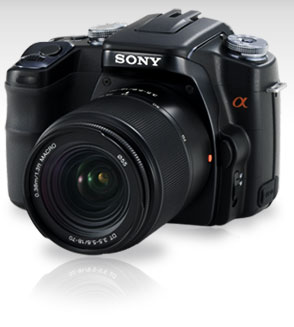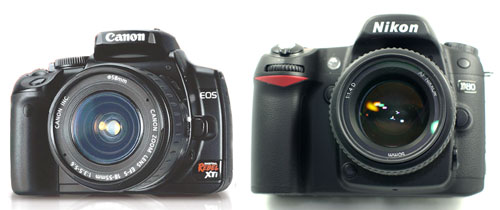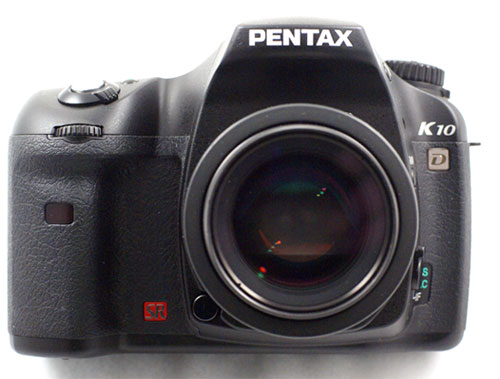10 Megapixel SLRs

The Sony A100 pioneered the 10 megapixel market when it was introduced this past summer. Sony acquired Minolta and based the new A100 on the entry level Minolta Maxxum 5D.

Sony continued the then-unique in-camera image stabilization pioneered by Minolta, which allowed any lens mounted on the camera to take sharper pictures at slower shutter speeds. Olympus had pioneered a popular feature that placed the sensor behind an antistatic protector, and that shook any stray dust off the sensor when the camera was turned on or shut down. Sony added a similar feature to their revision of the Maxxum digital SLR.
Sony inherited and continued the Minolta Maxxum autofocus lens mount, which meant almost any Minolta Maxxum lens ever made would work perfectly on the new Sony SLR camera. The A100 shocked the digital SLR market, since it brought the 10 megapixel resolution to market at a 6 megapixel price. This was also reflected in the selection of the Sony A100 as "Camera of the Year 2006" by the largest photo specialty magazine.

Canon and Nikon dominate the serious photography market, so it was no surprise that both followed in Sony's footsteps a couple of months later with their own 10 megapixel models. The Nikon D80 borrowed the processing engine, fast focusing module, and 10 megapixel sensor from their successful but expensive D200 model. All of the current 10 megapixel SLR cameras - except Canon - are based on the Sony 10 megapixel sensor. Nikon would point out, however, that the sensor interface and image processing "hardware" are their own design, and that the interface and processing account for much of how the sensor actually performs.
Canon basically increased the resolution of their CMOS sensor used in the 8 megapixel Rebel XT to 10 megapixels, and dubbed the revised camera the Canon Rebel XTi. They did incorporate the improved image processing guts of their semi-PRO 30D and finally added their own dust removal system - much like the one pioneered by Olympus. Canon also added dust removal capabilities to their bundled image-editing software.

The latest 10 megapixel SLR is the long-awaited Pentax K10D. Pentax took longest to get their 10 megapixel Sony sensor model to market, but the time certainly was not wasted. In many ways the Pentax is the most professional and full-featured of the 10 megapixel choices, since it incorporates special sealing for dust and moisture protection, similar to the sealing of the top professional SLR models. Pentax also refined the "in-camera" anti-shake pioneered by Minolta/Sony by adding permanent magnets in both horizontal and vertical planes. This allows rotation in the diagonal as well as horizontal/vertical planes and is claimed to extend low-light shooting up to four full f-stops.
Pentax also brought over their innovative hyper-program feature from top Pentax cameras of the past. This allows users to keep the camera on program and adjust either aperture or shutter speed to what they want in a shot. The program compensates by adjusting the other program variables automatically. Pentax added "ISO Priority" to the typical SLR offerings of full program (green zone), program, aperture-priority, shutter-priority, and full manual. This seemed a natural extension of one of the Digital SLR's best features - built-in film (Sensor) with very wide sensitivity (ISO). To top it off Pentax made sure the new K10D, and lower-priced K100D and K110D, would be fully compatible with any K-mount lens ever produced, including excellent "focus-assist" features for non AF lenses and the ability to manually dial in info from very old lenses that can still benefit from Pentax lens stabilization.
These four cameras are loaded with features and represent the current crop of 10 megapixel offerings. Samsung has also announced they will be marketing a 10 megapixel model just after the holidays which is to be called the Samsung GX-10. The new Samsung model is basically a relabeled Pentax with the same feature set.

The Sony A100 pioneered the 10 megapixel market when it was introduced this past summer. Sony acquired Minolta and based the new A100 on the entry level Minolta Maxxum 5D.

Sony continued the then-unique in-camera image stabilization pioneered by Minolta, which allowed any lens mounted on the camera to take sharper pictures at slower shutter speeds. Olympus had pioneered a popular feature that placed the sensor behind an antistatic protector, and that shook any stray dust off the sensor when the camera was turned on or shut down. Sony added a similar feature to their revision of the Maxxum digital SLR.
Sony inherited and continued the Minolta Maxxum autofocus lens mount, which meant almost any Minolta Maxxum lens ever made would work perfectly on the new Sony SLR camera. The A100 shocked the digital SLR market, since it brought the 10 megapixel resolution to market at a 6 megapixel price. This was also reflected in the selection of the Sony A100 as "Camera of the Year 2006" by the largest photo specialty magazine.

Canon and Nikon dominate the serious photography market, so it was no surprise that both followed in Sony's footsteps a couple of months later with their own 10 megapixel models. The Nikon D80 borrowed the processing engine, fast focusing module, and 10 megapixel sensor from their successful but expensive D200 model. All of the current 10 megapixel SLR cameras - except Canon - are based on the Sony 10 megapixel sensor. Nikon would point out, however, that the sensor interface and image processing "hardware" are their own design, and that the interface and processing account for much of how the sensor actually performs.
Canon basically increased the resolution of their CMOS sensor used in the 8 megapixel Rebel XT to 10 megapixels, and dubbed the revised camera the Canon Rebel XTi. They did incorporate the improved image processing guts of their semi-PRO 30D and finally added their own dust removal system - much like the one pioneered by Olympus. Canon also added dust removal capabilities to their bundled image-editing software.

The latest 10 megapixel SLR is the long-awaited Pentax K10D. Pentax took longest to get their 10 megapixel Sony sensor model to market, but the time certainly was not wasted. In many ways the Pentax is the most professional and full-featured of the 10 megapixel choices, since it incorporates special sealing for dust and moisture protection, similar to the sealing of the top professional SLR models. Pentax also refined the "in-camera" anti-shake pioneered by Minolta/Sony by adding permanent magnets in both horizontal and vertical planes. This allows rotation in the diagonal as well as horizontal/vertical planes and is claimed to extend low-light shooting up to four full f-stops.
Pentax also brought over their innovative hyper-program feature from top Pentax cameras of the past. This allows users to keep the camera on program and adjust either aperture or shutter speed to what they want in a shot. The program compensates by adjusting the other program variables automatically. Pentax added "ISO Priority" to the typical SLR offerings of full program (green zone), program, aperture-priority, shutter-priority, and full manual. This seemed a natural extension of one of the Digital SLR's best features - built-in film (Sensor) with very wide sensitivity (ISO). To top it off Pentax made sure the new K10D, and lower-priced K100D and K110D, would be fully compatible with any K-mount lens ever produced, including excellent "focus-assist" features for non AF lenses and the ability to manually dial in info from very old lenses that can still benefit from Pentax lens stabilization.
These four cameras are loaded with features and represent the current crop of 10 megapixel offerings. Samsung has also announced they will be marketing a 10 megapixel model just after the holidays which is to be called the Samsung GX-10. The new Samsung model is basically a relabeled Pentax with the same feature set.










89 Comments
View All Comments
soydios - Tuesday, December 26, 2006 - link
IMHO, this is a rather important fact that isn't in the article: the Nikon D40 (unlike every other Nikon DSLR) does not have an in-camera autofocus motor. This means that only Nikon AF-S lenses, which have the autofocus motor in the lens and are not nearly as prolific as the rest of the Nikon F-mount AF lens family, fully function on the D40. Older Nikon AF lenses, which are the entire reason that I purchased my D50 six months ago, do not autofocus on the D40.Awax - Tuesday, December 26, 2006 - link
Except for the 3 point autofocus and the lack of integrated lens autofocus engine, everything is better on the D40. The D40 will in 90% be associated with the kit lens only: this is an entry-level D-SLR and as it, is better than the D50. If you already own a D50, you'll better go for the D80. If you own an argentic SLR <ith many lenses, you'll probably buy new lens since the new generation digital only lenses are much better than the old/classical argentic lenses.PCHPlayer - Tuesday, December 26, 2006 - link
Did anyone else get the feeling that the author was a Pentax fanboy and the conclusion was going to be in favor of the Pentax line? Unfortunately I found the article quite shallow. I would highly recommend going to dpreview.com to get a real in-depth analysis of these cameras.Justin Case - Wednesday, December 27, 2006 - link
Personally, I just got the feeling the author is completely clueless. Take this paragraph, for example:"Sony continued the then-unique in-camera image stabilization pioneered by Minolta, which allowed any lens mounted on the camera to take sharper pictures at slower shutter speeds."
Image stabilization simply helps reduce blur caused by camera vibration. It won't do anything to make pictures "sharper". At slow shutter speeds, if the subject moves, the picture is going to be blurry, no matter what. Image stabilisation makes no difference to that. And if the subject doesn't move, then most of the time you can simply use a tripod (or rest the camera on top of a table, or whatever).
And to mention Sony and Minolta (and Pentax) as examples of image stabilization is ridiculous. Nikon's VR is 10x better than anything those three have ever done and Canon's IS is 5x better than Nikon's VR.
Then there's that amazing paragraph titled "COMPATABILITY" (sic), which basically reads as a love letter to Pentax. They've made 25 million lenses! Whoa! Leica have only made around 2 million, so I guess that makes them crap. Maybe I should sell my Summilux and "invest" in some K-mount glass? Sigh...
When someone considers that Pentax beats Canon and Nikon in terms of lens quality and selection, I think it's clearly time to call for the paramedics.
fass mut - Wednesday, December 27, 2006 - link
do you have link to the comparison between in body and lens stabilization? as far as i know, there is a slight benefit (.5 stop to maybe 1 stop) to in lens stabilization but that benefit is greatly off set by the price.buying a full range of lens with built in stabilization i.e. lenses that cover say 28 mm to 300 mm would cost a small fortune (~$2500-$4000 maybe more even). for me, that money saved could be plowed into better accessories like tripod, bag, flashes, heck even a faster computer or wide screen monitor to post process...but that's just my opinion.
Justin Case - Wednesday, December 27, 2006 - link
No amount of post-processing is going to recover detail that your lens didn't capture in the first place. When you invest in an SLR system, the main element are the lenses. That's the main difference between SLRs and compact cameras, and what some people don't seem to understand.If you can't afford good lenses, then use a compact camera instead. It's easier to use, cheaper, lighter, etc.., and can also take great pictures. Lots of great photographers use them. In some situations they're not just "as good" as an SLR, they're actually better.
And you don't need a full lens range with image stabilization. In fact, many great photographers managed to go through their entire careers without ever using ONE. But if you're going to use (and possibly rely on) image stabilization, you need it to actually be good, not just a marketing gimmick.
Lots of lenses aren't available in stabilized versions anyway. Lenses above 400mm are usually quite heavy, and used on a tripod, and below 70mm or so, vibration isn't a big problem. So a lot of photographers have only a couple of stabilized lenses, or even none at all (I have one, I might get one more, and I doubt I'll get any after that). Stabilized lenses are useful when you need to "track" subjects a lot, at long distances (ex., wildlife).
The only way you can really see the difference between proper optical image stabilization (ex., Canon IS or Nikon VR) and sensor stabilization (which has been used for a long time in video camcorders, BTW, namely Sony's) is by trying it.
It's not a matter of "how many stops" it gets you (that's just an over-simplification). It won't do anything for subject movement, and if you are using a tripod it won't make any difference. The effect depends on the vibration, and the vibration depends on each situation. If you are shooting a still subject under low light with no tripod, yes, maybe you can talk about gaining 2-3 stops with Canon IS. But that's just one specific situation.
It would be perfectly possible to add great image stabilization to cameras, but:
- It would make the cameras bigger
- It would make the cameras heavier
- It would make the cameras more expensive
And it's more or less useless when shooting at wide angles, and worse than useless when shooting on a tripod. 95% of people would never pay for it, or pick the heavier, bulkier camera. So some brands just use this "sensor stabilization" as a marketing gimmick, to make buyers think that, for an extra $75 or so they're getting image stabilization similar to what they'd get from a $1500 lens. They're not, of course.
I'm not saying it's a bad thing, but it's simply on a different league from lens stabilization, just as those MiniDV camcorder "stabilizers" are on a different league from a full SteadyCam harness.
The way the article's author dismisses VR / IS as if they were just an "overpriced version" of the same thing suggests that he never actually used it.
And I found it funny (though not surprising) that this AT article's "demonstration" of sensor stabilization was actually an unrealistic mock-up taken from an ad, not a real test image. In fact, it's funny how a review of four cameras manages to have so few pictures taken with those cameras and such poor pictures of the cameras themselves.
Photographers have a term for people who judge cameras by looking at their specifications (instead of at the images they produce): measurebation.
mongrelchild - Wednesday, December 27, 2006 - link
Get the hell out of here, Ken Rockwell.No one cares for your misinformation.
mongrelchild - Wednesday, December 27, 2006 - link
That was a reply for Justin Case, who by his preferring the K100's PQ to the K10s demonstrates that he has used neither of the products.Wesley Fink - Wednesday, December 27, 2006 - link
I have owned many Nikon and Canon film and digital cameras over the years - as well as a current Fuji S3 (Nikon lenses) and a D80. The Fuji S3 is well-suited to our work which is mostly "still-life" where the S3 excels. It would be a horrible camera for action photography. My last Canon Digital was a 20D. I have also owned both VR and IS lenses from Nikon and Canon, and have a fair amount of Nikon glass.There is definitely a place for lens-based VR/IS, but most of the VR/IS that I see being sold is for $200 Nikon/Canon entry zoom lenses that now cost $400 to $600 with lens integral anti-shake. It is easy to defend pro glass with IS, but most users who read this Buyers Guide will not spend $1500 to $2000 or more on the lenses you talk about, they will buy the $400 to $600 overpriced VR/IS zooms that are f4.0-F5.6 and not that great to start with. For most users, body-integral AS is a much better and cost-effective solution that works with any lens mounted - and yes it is more effective on some lenses than others.
Modern DSLR cameras communicate lens info to the processor, so it is possible for AS to be customized in processing for the lens in use. Under $1000 is still entry-level and this article is not aimed at Pro's. The entry kit lens for both are also pretty awful - both the Pentax kit and Sony kit are actually better lenses. At least Nikon offers a kit lens upgrade option, but it brings the price of the upgrade D80 kit to $1300.
Pentax and Minolta have made some superb AF lenses over the years. If you doubt that compare some lens qulaity ratings at www.photodo.com. Canon learned Pros want more than glass - they want the service and hand-holding that Nikon has provided to Pros for many years. Don't project the Pro orientation of Canon and Nikon into beliefs that their glass is superior, because it isn't. All four companies have some wonderful lenses and some dogs. Sony/Minolta, Pentax/Hoya, Canon and Nikon all have some pretty mediocre low cost lenses these days - aimed at low cost buyers. All four also have some superb glass. If you're a Pro who needs a long super-fast telephoto for a sports assignment - cost be damned - then you will find it at Canon or Nikon. However, for the photo enthusiast or hobbyist that is the intended audience for this guide, Pentax and Sony can give the buyer excellent selection and value.
Wesley Fink - Wednesday, December 27, 2006 - link
Since you seem the most vocal in calling me clueless I ask if you can please share your experiences when you tested the Pentax K10D and some of the new lenses like the 31mm f1.8 or 43 f1.9 or the pancake 21mm f3.2. Can you comment on the handling, build-quality, and lens line based on real hands-on experience? Or are your comments based on intuitive knowledge since everyone knows Canon and Nikon are the best?We tested ALL FOUR cameras in this review and we bought the cameras with kit lenses and 50mm F1.4 lenses. No manufacturer supplied samples for testing. We did borrow some lenses from friends for testing. Opinions are always welcomed, but you have turned your commenst into a personal vendetta. Since you have so much to say please share the basis of YOUR opinions. We would all like to hear you own personal testing experiences with the Pentax K10D.